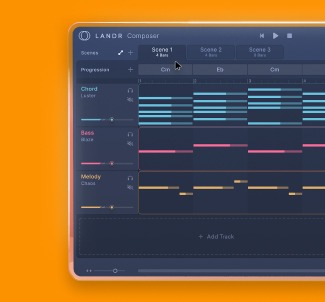
8 Minor Chord Progressions for Evocative, Emotional Songwriting
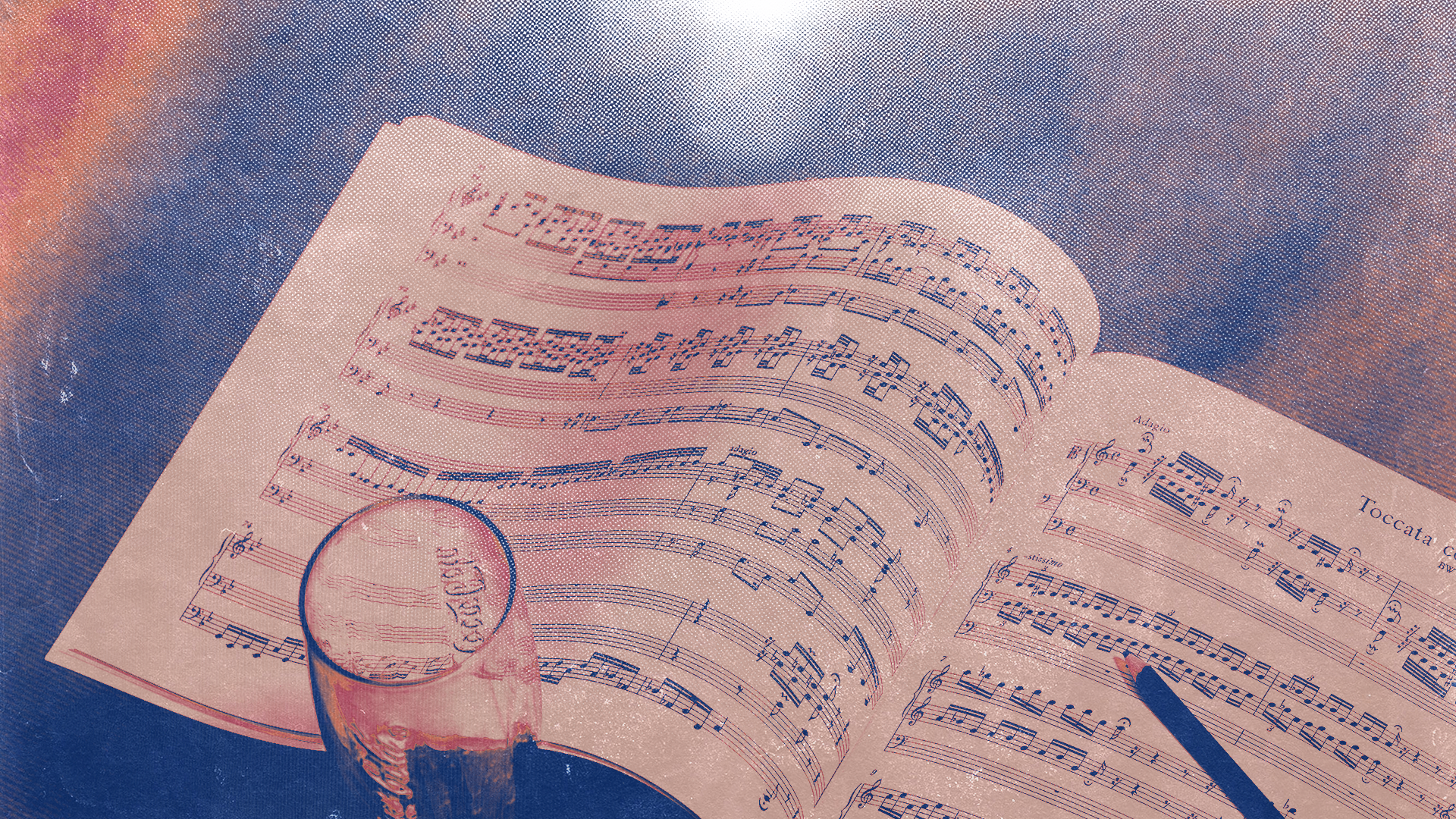
Ever hear a song that’s sad, but somehow it’s still uplifting, evocative and emotional? Chances are the artist is creatively using a minor chord progression.
They’re more common than you might think. In fact, many of today’s hottest, catchiest songs are written in a minor key.
Minor chord progressions are any chord progression written in a minor key. While they typically center around a minor chord, minor chord progressions can contain major chords that show up at different scale degrees depending on whether a natural, harmonic or melodic scale is being used to write the progression.
In this article, we’ll list a handful of great minor chord progressions and we’ll explore the chords the make them up.
Plus, we’ll look at a few more advanced examples where different minor scales and modal interchange is used to switch between major and minor keys, using a minor chord progression.
I even talked with our in-house experts about the best chord progressions to get the best advice about using minor chord progressions in your music.
Experts consulted
| Anthony Albanese | Music theory teacher |
Ready to learn everything you need to get started with writing minor chord progressions? Let’s dive in.
8 Minor Chord Progression Ideas
- Basic minor chord progressions
- Use the major chords in the natural minor scale
- The Andalusian cadence: Dire Straights - Sultans of Swing
- Melodic minor chord progression: Daft Punk - Get Lucky
- The dominant seventh turnaround
- Try not to start on the one-chord
- Advanced minor chord progression: “Crazy” - Gnarls Barkley
- Advanced minor chord progression: “I Can’t Go for That” - Hall and Oates
Before you start learning minor chord progressions
You need to know about the minor diatonic scale. Here’s a quick breakdown of each. Remember, if you need more help, check out our in-depth articles on the topic.
The natural minor diatonic chord scale
The natural minor diatonic chord scale takes the notes of a natural minor scale and uses each one as the foundation for building chords. It’s a great way to explore how chords relate to one another within a minor key.
Below is an illustration of the natural minor diatonic chord scale
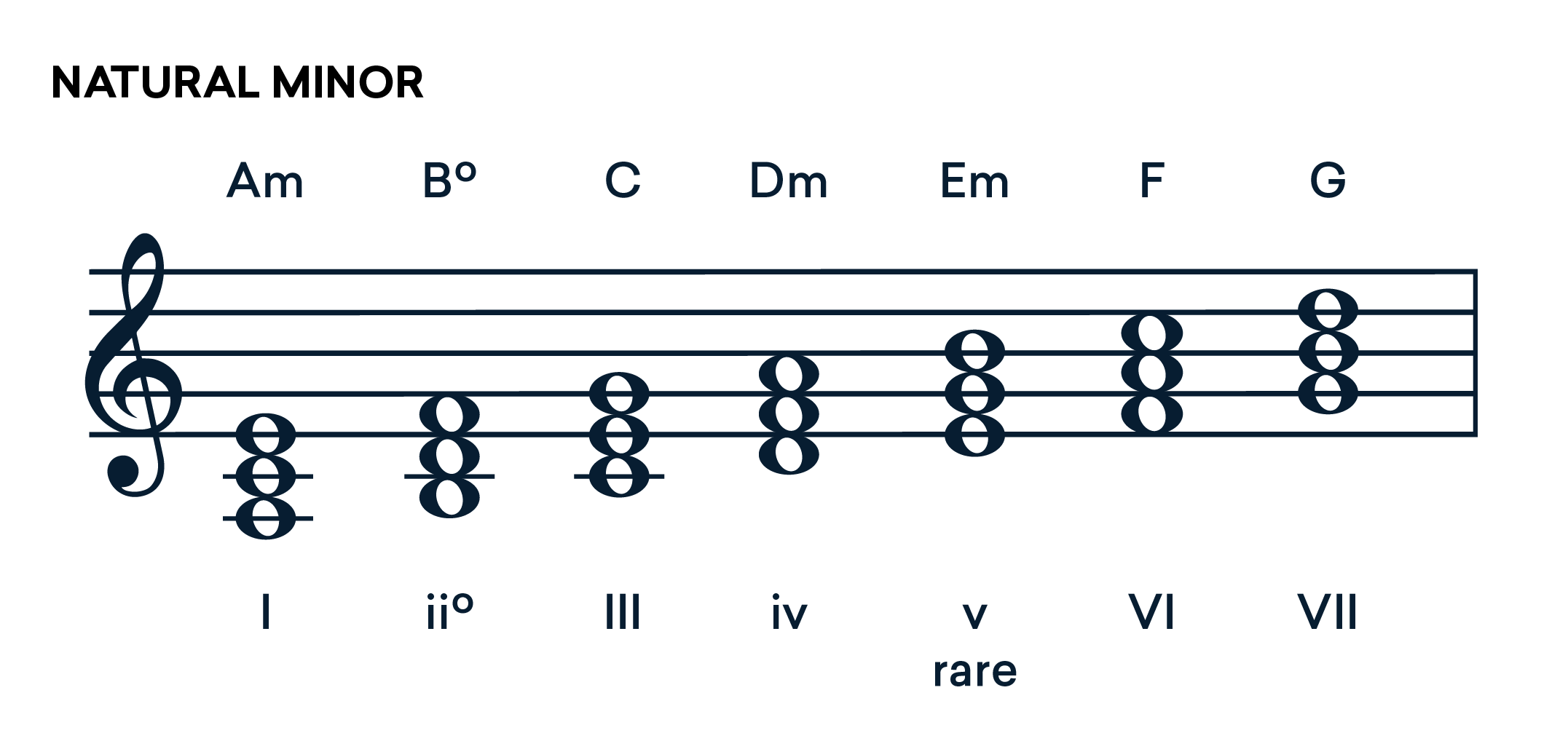
But the natural minor key is not the only way of writing minor chord progressions. You can also use the harmonic and melodic minor scale to write a minor chord progression, with each producing a slightly different effect.
The harmonic minor diatonic chord scale
The harmonic minor scale raises the seventh degree a half step.
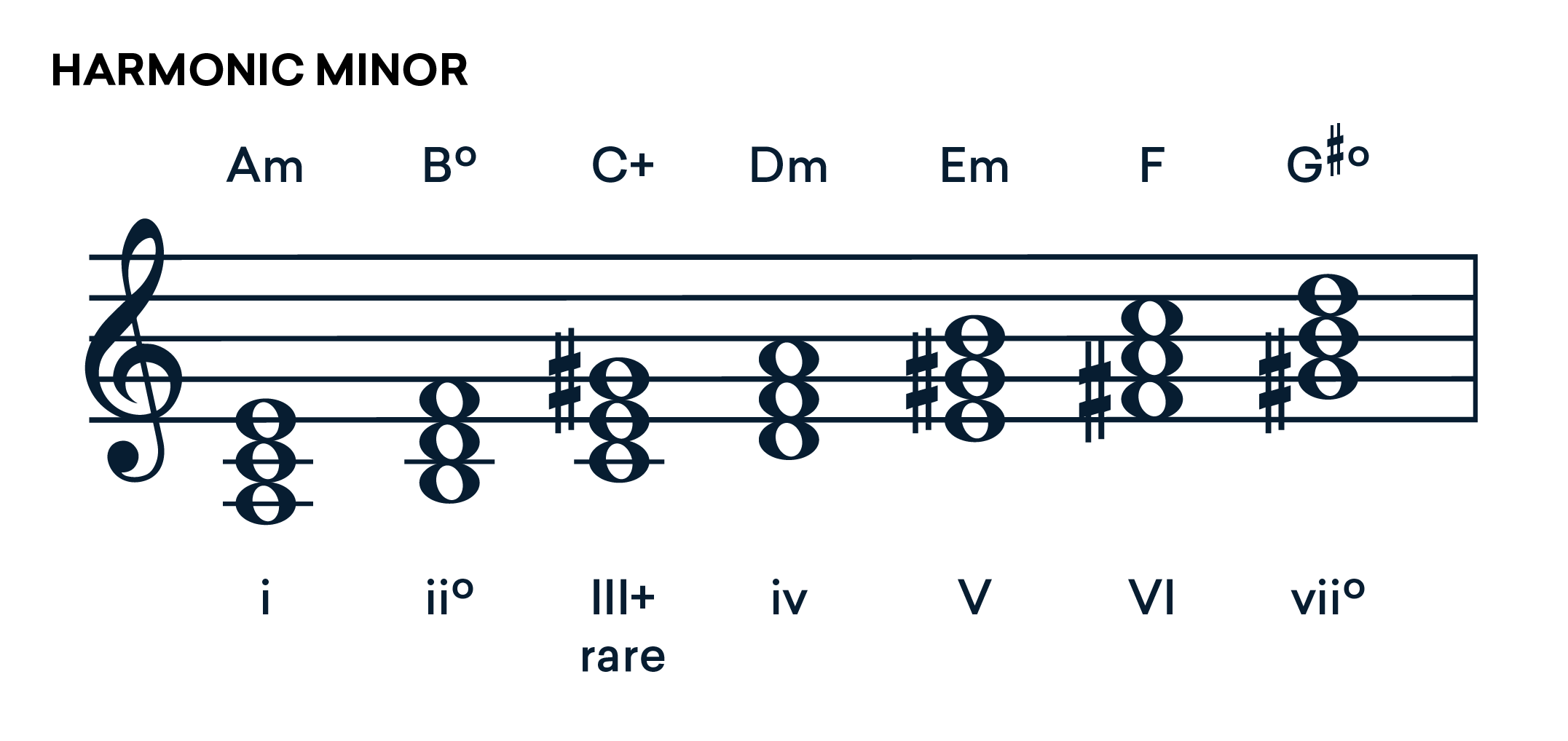
This impacts its diatonic scale by turning the third chord from a major chord to an augmented fifth chord, and the fifth chord from a minor chord to a major chord.
The VII chord which was major in the natural minor chord scale, becomes a diminished fifth triad because its root note goes up a half step.
With the fifth chord turned major, chord progressions written in harmonic minor sound slightly more hopeful than ones written in the natural minor scale.
The melodic minor diatonic chord scale
Building on the natural minor chord scale, the melodic minor scale raises the sixth degree a half step while also raising the seventh scale degree a half step like the harmonic minor scale.
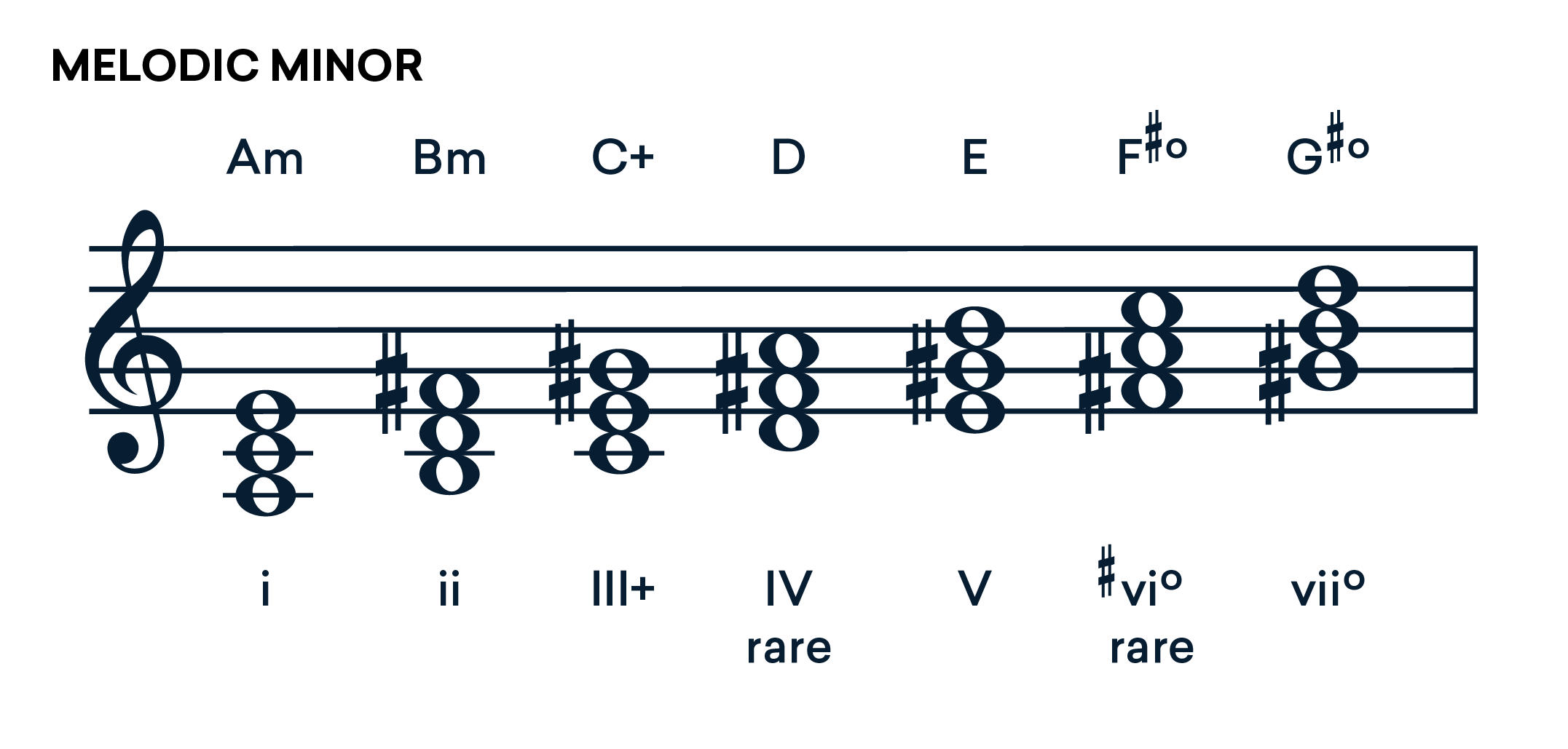
Under this scale, the fifth and fourth chords become major, while the sixth and seventh chords become diminished. The second and third chords become minor and augmented, respectively.
Why do these scales matter?
Conceptually, the melodic and harmonic scales are always bringing a minor key closer and closer to sounding more major, with a few caveats.
These scales move around the locations of the major chords in a minor key, when you start finding major chords and the fourth and fifth degree, it starts to resemble a major key’s diatonic chord scale.
Remember that no matter what scale you use, the I chord in each’s diationic scale is always a minor chord.
But by changing the scale, you can change where the major chords fall, while changing where diminished chords (which love to resolve to the one chord) fall.
With clever use of these, you can adjust how minor or major a chord progression sounds at will, opening a lot of creative avenues.
Alright, that’s enough theory. Let’s dive into our chord progressions.
"Minor chord progressions resonate deeply with listeners, evoking emotions that range from the ache of sadness to the triumph of overcoming adversity. They offer a powerful, dynamic foundation for crafting impactful musical ideas." - Anthony Albanese
1. Basic minor chord progressions
The most basic minor chord progressions are built using similar chords to their relative major scale.
In major keys and scales, the minor chords always land on the third and sixth degree of the diatonic chord scale. But in each major key’s relative minor key, those minor chords will always fall on the first, second, fourth and fifth degree of the scale.
The most common minor chord progressions start on the one chord, move to the fifth chord, and then move on to the major sixth, seventh and third chords found in major keys.
In the example above you’ll find three common versions of this kind of movement.
Each progression starts by moving from the sixth chord to the third chord, before moving on to other major chords.
This method is a great way to create a moodier sound while staying in a major key.
2. Use the major chords in the natural minor scale
Here’s another very common way of arranging a minor chord progression around the minor diatonic chord scale.
This progression uses the minor one chord and the cycles around the major chords of the natural minor diatonic chord scale.
This creates a brighter, more hopeful chord progression, especially because it uses the major third chord—which is always the chord of the minor key’s relative major.
If you’re using a minor chord progression like this one, be careful not to put too much emphasis on that major third chord, since it pulls heavily towards the minor’s relative major key and will make the chord progression sound major with too much emphasis.
Instead, use the major third chord more like a passing chord, briefly using it before cycling through the other chords on the way back to the minor one chord.
3. The Andalusian cadence: Dire Straights – Sultans of Swing
The Andalusian cadence is a famous minor chord progression dating back as early as the 15th century.
Despite being this old, the Andalusian cadence is used in many modern-day tracks, especially in guitar-based classic rock music like Dire Straights’ iconic track “Sultans of Swing”.
The Andalusian cadence is also the first chord progression on this list that is written in harmonic minor, using the scale’s raised 7th to make the fifth chord major.
In music theory, replacing a minor chord with a major chord is called modal interchange, moving the scale used in the key from the minor aeolian mode to the brighter mixolydian mode.
But if you find modes confusing, the main feature that makes the Andalusian cadence so interesting is its use of a cheery major fifth chord instead of the minor fifth chord.
4. Melodic minor chord progression: Daft Punk – Get Lucky
Daft Punk’s chart-topping hit Get Lucky is a great example of how songwriters can use both the natural minor scale and the melodic minor scale to create movement and a sense of hopefulness in their music.
Chances are you wouldn’t have guessed that Get Lucky is written in a minor key and that’s because it uses the melodic minor scale’s major IV chord as a substitution.
Adding this major chord to the chord progression adds a sense of hopefulness to the song.
If you’re writing a melody to a chord progression like this, just remember to use the raised sixth and seventh notes from the melodic minor scale whenever writing over the major IV chord.
5. The dominant seventh turnaround
Here’s another chord progression written in harmonic minor, since it uses major dominant seven chord. But let’s explore that dominant seven chord in more detail.
Whether major or minor, chord progressions that use dominant chords are music theory’s version of a fork in the road.
When you play one you are offering a choice, since dominant chords are always pulling towards a new tonal center.
A dominant fifth chord always wants to pull back to the one chord, and it’s a great way to create tension and emphasize a strong return to the “home” one chord.
But in some cases, like the example I’ll share next, a dominant chord can also be used to take a song to a new tonal center.
6. Try not to start on the one-chord
Here’s a simple albeit fairly interesting chord progression that’s been used in songs like The Cure’s Disintegration and in iconic video game soundtracks like Donkey Kong Country.
The chord progression start by cycling through two major sixth and seventh chords before resolving to the minor one chord.
Simple enough right? What’s interesting about the chord progression is that it resembles a deceptive cadence in a major key.
The sixth and seventh chords are the fourth and fifth chords in major key, meaning that the chord progression in a major context sounds like it should go to the major one chord.
But because we’re writing a minor chord progression, instead going to the minor one chord (which would be the third chord in the relative major key), it sound deceptive and mysterious.
That’s why chord progression is great for creating a sense of mystery and wonder, as you’ll especially hear in the iconic Donkey Kong Country piece Aquatic Ambiance.
7. Advanced minor chord progression: “Crazy” – Gnarls Barkley
Let’s take a look at a slightly more advanced way to use minor chord progressions.
Minor chord progressions are great for creating a moody, overcast sound which can be great for creating a sad or low-key sound.
But what if you want to move out of the clouds and let the sun in for a section of your track?
Arguably this is why using a minor chord progression is so appealing to many songwriters. Using well-timed modal interchanges with the help of a dominant chord change can add a satisfyingly major sound within the context of a strictly minor chord progression.
The chord progression of “Crazy” by Gnarls Barkley is a great example of this.
During the chorus, using the dominant chord to go back to the C minor one chord brings the song to a C major chord. This creates an uplifting sense of the clouds clearing.
This major sound, which briefly appears before using a dominant fifth chord to back to the C minor one chord, is an example of how minor chord progressions open up opportunities to use modal interchange to create a specific feeling or effect.
If you’re looking to bring your minor chord progression out of the darkness for a second, try leading into a major chord using a dominant fifth chord, then use the dominant fifth to bring it back to being minor.
8. Advanced minor chord progression: “I Can’t Go for That” – Hall and Oates
Here’s another example of how modal interchange is used to bring a song out of the clouds to create a brighter, more major section.
In “I Can’t Go for That” by Hall and Oates, the chorus also briefly switches from minor to major, replacing the C minor seventh one chord with a C major chord progression that cycles twice before switching back to C minor.
This slightly more abrupt change, which doesn’t use a dominant chord as a lead into the major section, still uses modal interchange to switch between major and minor sections.
It’s another great example of how minor chord progressions offer additional versatility. They give songwriters the ability to create a satisfying and uplifting feeling by switching to and from a major key.
Deep and meaningful minor chord progressions
Minor chord progressions open up endless possibilities for creating rich, evocative music.
Whether you’re exploring the emotional depth of a minor key, using modal interchange for surprising key changes, or adding just a hint of melancholy in a major key, these progressions are a powerful tool in your songwriting arsenal.
By experimenting with the examples we’ve covered, you’ll discover just how versatile minor chords can be.
Minor progressions can bring your songs to life with emotion and nuance, whether you’re crafting a moody ballad, an uplifting pop hit, or something in between.
So dive into your DAW, play around with these progressions, and let the music guide you.
The more you experiment, the better you’ll get at tapping into that emotional core that makes your tracks truly unforgettable.
Gear guides, tips, tutorials, inspiration and more—delivered weekly.
Keep up with the LANDR Blog.
